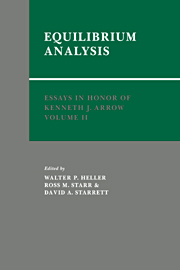Book contents
- Frontmatter
- Contents of Volumes I, II, III
- List of contributors
- Editors' preface
- Kenneth J. Arrow
- Contents
- PART I GENERAL EQUILIBRIUM
- 1 A general equilibrium theory of North–South trade
- 2 Soldiers of fortune?
- 3 The dynamics of industrywide learning
- 4 Decentralized trade in a credit economy
- 5 Lump-sum taxes and transfers: public debt in the overlapping-generations model
- 6 Coordination failure under complete markets with applications to effective demand
- PART II MICROFOUNDATIONS OF MACROECONOMICS
- Author index
5 - Lump-sum taxes and transfers: public debt in the overlapping-generations model
Published online by Cambridge University Press: 25 October 2011
- Frontmatter
- Contents of Volumes I, II, III
- List of contributors
- Editors' preface
- Kenneth J. Arrow
- Contents
- PART I GENERAL EQUILIBRIUM
- 1 A general equilibrium theory of North–South trade
- 2 Soldiers of fortune?
- 3 The dynamics of industrywide learning
- 4 Decentralized trade in a credit economy
- 5 Lump-sum taxes and transfers: public debt in the overlapping-generations model
- 6 Coordination failure under complete markets with applications to effective demand
- PART II MICROFOUNDATIONS OF MACROECONOMICS
- Author index
Summary
Introduction, summary, and reader's guide
Americans are hearing a lot these days about the government deficit and its integral, the public debt. The subject is hardly new for students of public finance and macroeconomics. In this chapter, we return to square one. We examine the nature of the intertemporal consistency restrictions imposed on the government's fiscal policy. In particular, we evaluate the basis for the current (“neo-Ricardian”) fixation with long-run debt retirement.
Our analysis is cast in terms of the standard overlapping-generations model of exchange. Consumers are assumed to possess perfect foresight. The government commits itself to a full intertemporal fiscal policy, which it announces at the beginning of time. There is assumed to be neither intrinsic uncertainty nor extrinsic uncertainty. The spot markets and the borrowing-and-lending markets are complete and competitive. Participation in these markets is restricted only by the natural lifetimes of the consumers. Since sunspot equilibria are ruled out by assumption, the restrictions on market participation are not essential.
Trading is assumed to be costless. Financial assets have only two roles. They are potential value stores. They can also be used by consumers in paying their taxes (and by the government in distributing transfers). In this environment, financial instruments are in essence identical. We can assume, therefore, that there is only one type of instrument, called “money.” (Since it serves no special role in facilitating exchange, you might prefer to think of this instrument as a “bond,” a bond that does not pay nominal interest but can appreciate in value relative to commodities.
- Type
- Chapter
- Information
- Essays in Honor of Kenneth J. Arrow , pp. 121 - 154Publisher: Cambridge University PressPrint publication year: 1986
- 1
- Cited by



